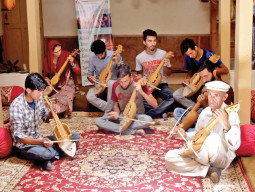
For two or three weeks in April the ground of the Hallerbos wood just outside the drab capital of Brussels is transformed into a breathtaking sea of shimmering purple.
"The scene is like in a fairytale, we're still expecting a little elf or witch to appear from nowhere," says Marie-Rose, who is walking through with her husband.
When travel meets nature through art
They are among tens of thousands of visitors from as far afield as India, Finland and Japan who flock each year to what had long been one of Belgium's best kept secrets.
At the start of spring the tall beech trees are still bare enough to let enough sunlight reach the forest floor and allow the flowers to bloom.
Huge swathes of the 555-hectare (1,370-acre) woodland are covered in millions of the delicate purple flowers for as far as the eye can see.
"This place is unique, the only one like it in Europe, in the world I think," says Adrien, who is taking 360 degree photos of the forest.
Bluebells have been growing in Hallerbos for centuries, experts say.
The forest was largely cut down by the invading German army during World War II but replanted afterwards with beech trees and a few Californian sequoias, and the fresh cover has allowed them to really flourish.
But its growing popularity in recent years comes at a cost.
At the weekends, the sheer numbers coming to visit the forest have forced Belgian authorities to set up special parking lots and shuttle buses, with visitors finding themselves among school parties, groups of tourists and photographers lugging their equipment.
More importantly they set up signs asking visitors to keep off the carpet of flowers and stick to the pathways, with especially vulnerable areas being taped off.
"When there's too much trampling the bluebells disappear and it takes dozens if not hundreds of years for them to grow again," says Bruno Verhelpen, a guide who organises nature walks at Hallerbos.
"The interest in this forest is only going to grow. There are photographers, naturalists, members of the public. So we have had to take measures to limit traffic."
In the next two weeks as the flowers are in full bloom the forest paths will be so busy they will be "like a commercial street in central Brussels".
One of the biggest risks is from people taking selfies in the woods, says Pierre Kestemont, a forest ranger who runs the www.hallerbos.be website.
Close to nature: A trip inside the wild and wonderful world of Changa Manga
"A few years ago you'd get a few people taking pictures in the middle of the flowers, sometimes in strange outfits, but it was nothing serious. But now everyone has a smartphone and has turned into a photographer," says Kestemont, who spends up to 12 hours a day cycling around making sure people keep to the paths.
"At the end of each day I can see where they have been walking. You can destroy in a week what nature has taken centuries to create."

































1714024018-0/ModiLara-(1)1714024018-0-270x192.webp)









COMMENTS
Comments are moderated and generally will be posted if they are on-topic and not abusive.
For more information, please see our Comments FAQ